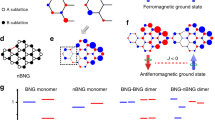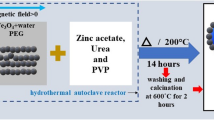Abstract
Hybrid nanostructures which are made of 2D architecture have potential applicability in many fields. While spin crossover (SCO) materials have bistability in spin states, their application is limited due to structural delicacy. Combining the flatness of 2D template and unique spin state transition property of SCO, we prepared a hybrid nanocomposite that can detect molecular spin transition at elevated temperatures. We choose chemically synthesized reduced graphene oxide (rGO) due to its plethora of available functional groups on the surface to bind SCO nanoparticle networks. Triazole ligand-based (Trz) Fe(II) SCO network is used due to its versatility. By tuning the coverage area of SCO nanoparticle’s network, 4 to 15 nm thickness variation is observed. The hybrid’s magnetic characterization reveals a field induced excited spin state transition with large thermal hysteresis (~ 40K) at high temperature. Due to interfacial substrate interaction, interchain coupling has enhanced, and ferromagnetic ordering is found in the heterostructure.
Graphical abstract
[Fe(Htrz)2(trz)]BF4-based nanoparticle network grown on rGO surface Inset shows spin state transition with large hysteretic behavior.





Similar content being viewed by others
Data availability
All the data related to this work are available from the authors upon reasonable request.
References
A. Bousseksou, G. Molnár, L. Salmon, W. Nicolazzi, Chem. Soc. Rev. 40, 3313 (2011)
J.F. Létard, P. Guionneau, L. Goux-Capes, P. Gütlich, H.A. Goodwin, Towards spin crossover applications, vol. 235 (Springer, Berlin, 2004), p.221
L. Salmon et al., New J. Chem. 33, 1283 (2009)
S. Ohkoshi, K. Imoto, Y. Tsunobuchi, S. Takano, H. Tokoro, Nat. Chem. 3, 564 (2011)
O. Kahn, C.J. Martinez, Science 279, 44–48 (1998)
A. Bousseksou, G. Molna’r, P. Demont, J. Menegotto, J. Mater. Chem. 13, 2069–2071 (2003)
H. Spiering, E. Meissner, H. Koppen, E.W. Muller, P. Gutlich, Chem. Phys. 68, 65 (1982)
F.J. Valverde-Muñoz, M. Seredyuk, M. Meneses-Sánchez, M. Carmen Muñoz, C. Bartual-Murgui, J.A. Real, Chem. Sci. 10, 3807–3816 (2019)
T. Myamachi, M. Gruber, V. Davesne, M. Bowen, S. Boukari, L. Joly, F. Scheurer, G. Rogez, T.K. Yamada, P. Ohresser, E. Beaurepaire, W. Wulfhekel, Nat. Commun. 3, 938 (2012)
B. Warner, J.C. Oberg, T.G. Gill, F. Hallak, C.F. Hirjibehedin, M. Serri, S. Heutz, M. Arrio, P. Sainctavit, M. Mannini, G. Poneti, R. Sessoli, P. Rosa, J. Phys. Chem. Lett. 4, 1546 (2013)
C. Fourmental, S. Mondal, R. Banerjee, A. Bellec, Y. Garreau, A. Coati, C. Chacon, Y. Girard, J. Lagoute, S. Rousset, M.-L. Boillot, T. Mallah, C. Enachescu, C. Barreteau, Y.J. Dappe, A. Smogunov, S. Narasimhan, V. Repain, J. Phys. Chem. Lett. 10, 4103 (2019)
S. Beniwal, S. Sarkar, F. Baier, B. Weber, P. Dowben, A. Enders, J. Phys.: Condens. Matter 32, 324003 (2020)
M. Mannini, F. Pineider, P. Sainctavit, C. Danieli, E. Otero, C. Sciancalepore, A.M. Talarico, M.A. Arrio, A. Cornia, D. Gatteschi, R. Sessoli, Nat. Mater. 8, 194–197 (2009)
R. Vincent, S. Klyatskaya, M. Ruben, W. Wernsdorfer, F. Balestro, Nature 488, 357–360 (2012)
E. Coronado, Nat. Rev. Mater. 5, 87–104 (2020)
M. Gime’nez-Marque’s, M.L. Larreaa, E. Coronado, J. Mater. Chem. C 3, 7946–7953 (2015)
C. Bartual-Murgui, E. Natividad, O. Roubeau, J. Mater. Chem. C 3, 7916 (2015)
K.S. Kumar, M. Ruben, Coord. Chem. Rev. 346, 176–205 (2017)
L. Kipgen, M. Bernien, F. Tuczek, W. Kuch, Adv. Mater. 33, 2008141 (2021)
M. Gruber, R. Berndt, Magnetochemistry 6, 35 (2020)
C. Lochenie, W. Bauer, A.P. Railliet, S. Schlamp, Y. Garcia, B. Weber, Inorg. Chem. 53(21), 11563–11572 (2014)
O. Roubeau, Chem. Eur. J. 18, 15230–15244 (2012)
S. Bhattacharya, W. Choi, A. Ghosh, S. Lee, G.D. Lee, S.K. Kim, Nanotechnology 32, 385705 (2021). https://doi.org/10.1088/1361-6528/ac0b62
S. Bhattacharya, D. Dinda, E. Kumar, R. Thapa, S.K. Saha, J. Appl. Phys. 125, 233904 (2019)
S. Bhattacharya, S.K. Saha, Macromol. Symp. 376(1), 1600183 (2017)
A. Debnath, B. Shaw, S. Bhattacharya, S.K. Saha, J. Phys. D Appl. Phys. 54(20), 205001 (2021)
C. Majumder, T.K. Mondal, S. Bhattacharya, S.K. Saha, J. Magn. Magn. Mater. 559, 169439 (2022)
Acknowledgments
S.B. acknowledges Japan Society for the Promotion of Science for providing JSPS International Postdoctoral Fellowship (ID P20070) during this work. H. T acknowledges Grant-in-aid for Scientific Research from JSPS KAKENHI (Project Numbers 22H00315 and 22F20070) for financial support during this work.
Author information
Authors and Affiliations
Corresponding authors
Ethics declarations
Conflict of interest
The authors state that there is no conflict of interest.
Additional information
Publisher's Note
Springer Nature remains neutral with regard to jurisdictional claims in published maps and institutional affiliations.
Supplementary Information
Below is the link to the electronic supplementary material.
Rights and permissions
Springer Nature or its licensor (e.g. a society or other partner) holds exclusive rights to this article under a publishing agreement with the author(s) or other rightsholder(s); author self-archiving of the accepted manuscript version of this article is solely governed by the terms of such publishing agreement and applicable law.
About this article
Cite this article
Bhattacharya, S., Tada, H. Magnetic field induced cooperativity tuning in a Fe(II)-based hybrid spin crossover network grown on 2D surfaces. MRS Advances 8, 894–900 (2023). https://doi.org/10.1557/s43580-023-00639-6
Received:
Accepted:
Published:
Issue Date:
DOI: https://doi.org/10.1557/s43580-023-00639-6




